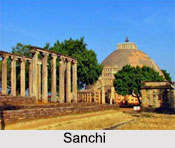 Holy Cities of Central India comprise the cities in Madhya Pradesh and Chhattisgarh. These two states have tribal population and there are many temples of Chandella Dynasty of Madhya Pradesh, Pala Dynasty and Sena Dynasty of Bengal.
Holy Cities of Central India comprise the cities in Madhya Pradesh and Chhattisgarh. These two states have tribal population and there are many temples of Chandella Dynasty of Madhya Pradesh, Pala Dynasty and Sena Dynasty of Bengal.
Amarkantak
Amarkantak is the temple town in Madhya Pradesh. It is under the Anuppur in MP. This place has many temples and Buddha circuits and it is also the meeting point of Vindhya Mountain Range and the Satpura Mountain Range, with the Maikal Hills being the swivel.
Ujjain
Ujjain is the largest city in Ujjain district of Madhya Pradesh. Ujjain was ruled by many dynasties till it came under the Muslim rule in medieval India. It is an ancient city located on the eastern bank of the Kshipra River. Mahakaleshwar Jyotirlinga, Kaal Bhairav Mandir, Ved Shala and the ISKON temple are the temples in Ujjain. It remained an important political, commercial and cultural centre of central India until early 19th century, when the British administrators decided to develop Indore as an alternative to it.
 Burhanpur
Burhanpur
Burhanpur is the temple city in Madhya Pradesh, situated on the north bank of the Tapti River. Burhanpur came in the lime light when Emperor Shah Jahan came to hunt the lions. The excavation stated that Burhanpur was under the Rashtrakutas Dynasty in early India.
Indore
Indore was developed by the British East India Company and later the British Government in India. It was royal seat of Madhya Pradesh, located on the southern edge of Malwa Plateau. Indore in Indore District of Madhya Pradesh has Mandu, now the ruined city. Indore served as the capital of the Madhya Bharat from 1950 until 1956.
Sanchi
Sanchi is a Buddhist pilgrimage location in Madhya Pradesh and it is the oldest stone structure in India, commissioned by Emperor Ashoka in the 3rd century BC. It is now in Raisen District of Madhya Pradesh.
Sirpur
Sirpur is a historical town in Mahasamund district in the state of Chhattisgarh. It is located 78 km away from Raipur and 35 km from Mahasamund city on the banks of the Mahanadi River. Sirpur was an important centre of Buddhist from the 6th to 10th century A.D. and was visited by Hieun Tsang, the 7th Century Chinese scholar. Sirpur has Laxman Temple, Buddha Vihara and Gandheshwar Temple.



















